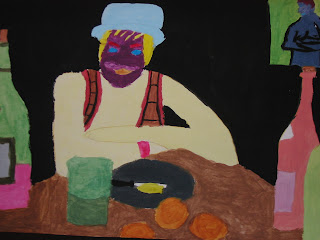Como puedes observar, hay algunos trabajos realmente muy interesantes. Si quieres ver alguno de ellos a mayor tamaño, simplemente haz click sobre él.
Blog con contenidos elaborados por los alumnos del Dpto. de Dibujo del I.E.S. Cristo del Socorro
jueves, 1 de marzo de 2012
Trabajos con Temperas 3º ESO (2ª parte)
A continuación encontrarás fotografías de los trabajos a tempera realizados por alumnos de 3º ESO del curso 2011-2012.
Como puedes observar, hay algunos trabajos realmente muy interesantes. Si quieres ver alguno de ellos a mayor tamaño, simplemente haz click sobre él.











Como puedes observar, hay algunos trabajos realmente muy interesantes. Si quieres ver alguno de ellos a mayor tamaño, simplemente haz click sobre él.
Trabajos con Temperas 3º ESO (1ª parte)
lunes, 27 de febrero de 2012
Cubism
Cubism was an artistic movement that was born in France between 1907 and
1914. Pablo Ruiz Picasso was the first artist who uses this style. The term
“cubism” was created by Louis Vaxcelles because he said that this style was
composed of “little cubes”, and it started call cubism.
Cubism is considered the first avant-garde because broke with renaissance at beginning of twentieth century. Perspective disappears in cubism and start painting geometric forms. Those works represents all sides of an object in the same plane, so it’s more difficult to see clearly a person or an animal. Now there is no single point of view, so sensation of distance disappears. Painters deleted details and used darker colors than they used in impressionism.
Picasso and Braque founded cubism, but also there were other painters who were famous because of this kind of art. Like Albert Gleizes, Jean Metzinger, Juan Gris, Fernand Léger and André Lhote.
Cubism is considered the first avant-garde because broke with renaissance at beginning of twentieth century. Perspective disappears in cubism and start painting geometric forms. Those works represents all sides of an object in the same plane, so it’s more difficult to see clearly a person or an animal. Now there is no single point of view, so sensation of distance disappears. Painters deleted details and used darker colors than they used in impressionism.
Picasso and Braque founded cubism, but also there were other painters who were famous because of this kind of art. Like Albert Gleizes, Jean Metzinger, Juan Gris, Fernand Léger and André Lhote.
 |
| Pablo Picasso: Guernica. Museo Reina Sofía (Madrid) |
 |
| Pablo Picasso: The Three Musicians (1921). Metropolitan Museum of Art (New York City) |
Author: Pablo Ruiz Morales
sábado, 25 de febrero de 2012
Pop Art
Pop art is an art movement that emerged in Britain and in the United States. The concept of pop art refers not as much to the art itself as to the attitudes that led to it.
Pop art is aimed to employ images of popular as opposed to elitist culture in art, emphasizing the banal elements of any given culture, most often through the use of irony. It is also associated with the artists use of mechanical means of reproduction or rendering techniques.
Much of pop art is considered incongruent, as the conceptual practices that are often used make it difficult for some to readily comprehend. Pop art and minimalism are considered to be art movements that precede postmodern art, or are some of the earliest examples of Postmodern Art themselves.
Pop art often takes as its imagery that which is currently in use in advertising. Product labeling and logos figure prominently in the imagery chosen by pop artists, like in the Campbell's Soup Cans labels, by Andy Warhol. Even the labeling on the shipping carton containing retail items has been used as subject matter in pop art.
 |
| Andy Warhol: Marilyn Monroe (1962) |
 |
| Roy Lichstenstein: Whaam! (1963) |
Author: Irene Serrano Menéndez (based on Wikipedia article)
Suscribirse a:
Entradas (Atom)